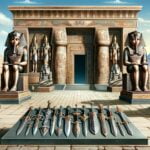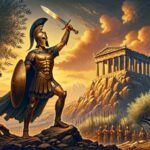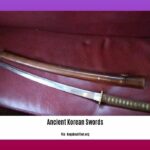Have you ever pondered the significance of a sword in ancient Greece? More than mere weapons, these blades were potent symbols of status and power, essential tools for daily life, and integral components of religious ceremonies. From the rudimentary bronze creations to the sophisticated iron weapons, we will delve into the complete story of these remarkable artifacts. Learn more about ancient Greek armor here.
Ancient Greek Swords: History, Types, and Cultural Impact
Embark on a journey to explore the captivating world of ancient Greek swords. Their evolution mirrors the technological advancements and cultural shifts of ancient Greece, offering valuable insights into the society that wielded them. From their battlefield use to their symbolic weight, what can these weapons teach us about ancient Greek civilization?
Bronze Age Beginnings: Forging Early Warfare Technology
During the Bronze Age, bronze was the cutting-edge material. Greek swords from this era were shorter and stouter compared to their iron counterparts, owing to bronze’s inherent limitations. Swords were often created using molds and basic tools. How did the limitations of bronze shape early Greek combat?
The Iron Age Revolution: Metallurgical Innovation and its Impact
The introduction of iron was revolutionary. Iron’s superior strength and flexibility facilitated the creation of longer, sharper, and more durable swords. This transition marked a significant leap forward in weaponry. This era also saw the rise of the iconic xiphos, a double-edged sword favored by hoplites. The xiphos was designed for both thrusting and slashing, becoming the quintessential weapon for close-quarters combat.
Beyond the Xiphos: Exploring Diverse Weaponry and Military Tactics
The xiphos wasn’t the sole sword in ancient Greece. The kopis, with its single-edged, curved blade, was ideal for powerful slashing attacks and favored by cavalry soldiers. The machaira, another single-edged sword, often shorter than the kopis, found utility among both cavalry and infantry. Were there specific combat techniques associated with different sword types?
Swords as Ancient Greek Status Symbols and Cultural Icons
Ancient Greek swords transcended their role as mere weapons of war; they were potent symbols of status, power, and cultural identity. Swords appear extensively in art, mythology, and everyday life, underscoring their profound cultural significance. They played a crucial role in religious ceremonies, symbolizing power and a connection to the divine. Owning a sword could signify prestige and wealth. How did these cultural associations influence the design and decoration of swords?
Regional Variations: Cultural Diversity and Weaponry Across Ancient Greece
Though certain sword types were prevalent throughout Greece, notable regional variations existed. These distinctions likely reflected local preferences, available materials, and regional artistic styles. What do these regional variations reveal about trade, cultural exchange, and local identity?
Swords in Religious Ceremonies and Funerary Rites
Swords held deep religious significance in ancient Greece. They were often included in religious ceremonies and funerary rites, symbolizing power, protection, and the transition to the afterlife. Archaeological discoveries of swords in tombs further attest to their symbolic importance. What does the presence of swords in burials tell us about ancient Greek beliefs?
A Lasting Legacy: Ancient Greek Swords in Modern Culture and Beyond
The evolution of ancient Greek swords, from simple bronze blades to sophisticated iron weapons, mirrors the broader technological and cultural development of ancient Greece. They offer a unique perspective into the past, shedding light on military power and cultural depth. Archaeologists and scholars continue to enhance our understanding of these remarkable blades.
Summary Table of Common Ancient Greek Swords
| Sword Type | Description | Typical Use |
|---|---|---|
| Xiphos | Double-edged, relatively short, leaf-shaped | Hoplites (infantry), close-quarters combat |
| Kopis | Single-edged, curved, heavier blade | Cavalry, slashing attacks, chopping |
| Machaira | Single-edged, curved, often shorter than kopis, various designs | Cavalry, infantry, versatile uses |
| Naue II | Cut-and-thrust sword, riveted hilt | Early warfare, both cutting and thrusting |
| Encheiridion | Short sword, stabbing weapon | Spartans |
This table provides a simplified overview, acknowledging that ongoing research continues to refine our understanding of different types of ancient Greek swords.
Metallurgical Advancements and Ancient Greek Sword Design
How did metallurgical advancements influence ancient Greek sword design and battlefield tactics?
Key Takeaways:
- Bronze Age swords were constrained by bronze’s properties.
- The Iron Age revolutionized sword design and battlefield effectiveness.
- The xiphos, kopis, and machaira represent diverse combat roles.
- Metallurgical improvements directly impacted Greek military strategies.
- Swords held deep cultural significance.
From Bronze to Iron: A Metallurgical Revolution
Bronze swords, while a significant advancement, were limited by the metal’s properties, often thick, prone to bending, and requiring frequent sharpening. The advent of ironworking introduced stronger, more flexible swords. What specific ironworking techniques contributed to the effectiveness of Greek swords?
The Xiphos: The Hoplite’s Companion in Greek Warfare
The xiphos, a short sword favored by hoplites, embodies this transformation. Forged from iron, it was ideal for both thrusting and slashing in dense phalanx formations, a design resulting from metallurgical advancements improving iron’s properties. How did the xiphos contribute to the dominance of the hoplite phalanx?
Beyond the Xiphos: Specialization and Adaptation in Weaponry
The Iron Age fostered specialization. The kopis, a curved sword, gained popularity among cavalry, facilitating powerful slashing attacks suited to mounted combat. The machaira, a single-edged sword, offered tactical advantages with its length. How did these specialized weapons influence Greek cavalry tactics?
Swords in Daily Life
Beyond battlefield roles, swords held cultural significance. Depictions on pottery, sculptures, and literature highlight their importance in daily life and religious ceremonies. Passed down through generations, swords symbolized honor, heroism, and lineage. What role did swords play in Greek mythology?
Regional Variations and Naval Warfare
While certain types of swords were prevalent, regional variations existed. The rugged mountainous terrain and extensive coastline of Greece influenced weapon design, with some swords suited for close-quarters combat and others for naval engagements. How did geography contribute to variations in sword design and usage?
Ancient Greek Swords in Farming and Other Non-Military Contexts
Key Takeaways:
- Swords held significant cultural and religious meaning.
- Sword design evolved, reflecting metallurgical advancements.
- Several distinct sword types existed, each with unique characteristics.
- Swords played a role in rituals, burials, and as symbols of status.
- Regional variations reflected differences in local traditions.
Bronze Age Blades: The Early Days
The earliest Greek swords were crafted from bronze and often cast, resulting in decorative designs. Their shapes were typically longer and double-edged, reflecting the combat styles of the time. How did bronze sword designs influence later iron sword development?
The Iron Age Revolution: Sharper Blades and New Tactics
The introduction of iron marked a turning point, allowing for stronger, sharper, and more durable blades. This innovation refined tactics and led to the development of distinct sword types catering to different combat styles. What evidence suggests that the change from bronze to iron affected trade networks?
Types of Ancient Greek Swords and Their Function
Let’s explore the most famous:
- Xiphos: A short, double-edged sword, perfect for thrusting attacks in close quarters.
- Kopis: A longer, single-edged, curved blade ideal for slashing.
- Machaira: Its exact nature remains debated, sometimes considered a variant of the kopis, other times a separate entity altogether.
Beyond the Battlefield: Swords in Religious and Social Contexts
Ancient Greek swords held significant cultural importance, appearing in religious ceremonies, adorning funerary rites, and serving as symbols of power and status. What types of individuals were most likely to possess elaborately decorated swords?
Regional Variations: History Across Ancient Greece
The varied geography of ancient Greece influenced the design and usage of swords. Different terrains and combat styles produced regional differences in blade shapes and techniques.
| Region | Sword Type | Notable Features |
|---|---|---|
| Mainland Greece | Xiphos, Kopis | Versatile for various combat situations |
| Island Regions | Shorter, curved blades | Adaptable for close-quarters shipboard combat |
| Sparta | Encheiridion | Short, stabbing weapon for close combat |
A Legacy of Steel: The Enduring Greek Impact
From their bronze origins to their iron zenith, these blades played a dual role: instruments of war and symbols of culture, deeply woven into the fabric of ancient Greek society and religion. What can the study of ancient Greek swords tell us about the values of ancient Greek society?
Key Takeaways:
- Ancient Greek sword design evolved dramatically.
- The xiphos, kopis, and Naue II swords represent distinct eras.
- Swords held deep cultural and symbolic meaning.
- Swords extended beyond the battlefield into daily life.
Farming and Protection: The Role of Ancient Greek Swords in Everyday Life
Imagine a world where your sword isn’t just for battle. In ancient Greece, swords played a role in farming and other non-military contexts. While spears were the primary weapon for hoplites, swords were a necessary tool for self-defense, hunting, and even agriculture. The hardy machaira could be used for clearing brush or protecting oneself from animals. How did the need for versatile tools influence sword design?
Swords as Ancient Greek Status Symbols: More Than Just Weapons
Swords also served as status symbols. A well-crafted and maintained sword could signify wealth and prestige. They were often displayed prominently as a sign of power and authority. How did this emphasis on status influence the craftsmanship of swords?
Regional Styles of Ancient Greek Weaponry
The design and use of swords varied geographically. Regional differences in fighting styles and preferred materials resulted in distinct styles. A rugged mountain environment might favor a shorter, more easily wielded blade, while a plains region might accommodate longer weapons. How did trade networks influence the dissemination of different sword styles across the Greek world?
The Legacy of the Greek Sword
The evolution of Greek swords reflects a powerful interplay between technological innovation, military strategies, and cultural values. From the delicate bronze blades of the Bronze Age to the formidable iron weapons of later periods, these weapons played a central role in the formation of one of history’s most influential civilizations. What lessons can be learned from the study of ancient Greek swords about the relationship between technology and society?
- Discover Ancient Greece Weapons: A Comprehensive Guide to Military Technology - August 8, 2025
- Discover Ancient Greek Swords: A Comprehensive Guide - August 8, 2025
- Explore Ancient Athens: Unveiling the City’s Secrets Through Maps - August 8, 2025















